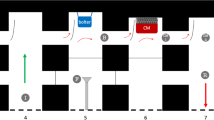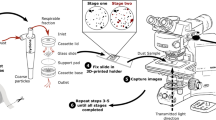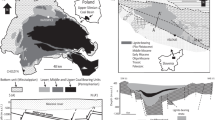Abstract
A previous effort to characterize respirable coal mine dust in 16 US mines turned up a curious finding: particle-based analysis using scanning electron microscopy (SEM) tended to overpredict the abundance of dust sourced from rock strata, and underpredict the abundance of coal, when compared to mass-based thermogravimetric analysis (TGA). One possible explanation is the occurrence of coal-mineral microagglomerates (MAGs). Coal particles covered with fine mineral dust could be mostly coal by mass but classified as minerals by SEM due to their surface elemental content. In the current study, a subset of the previously analyzed mine dust samples was re-examined, and SEM images and elemental mapping showed that MAGs are indeed present. Furthermore, dust samples were created and sampled passively in the laboratory, demonstrating that MAG formation can occur due to dust generation processes and the sampling environment, rather than as a mere artifact of respirable dust sampling procedures. Finally, experiments were conducted to evaluate dispersibility of MAGs in liquid suspensions, which might shed some light on their possible fate upon inhalation. Results indicated that sonication in deionized water was effective for MAG dispersion, and a solution that mimics natural lung surfactant also appeared to enhance dispersibility. An understanding of MAG occurrence might be important in terms of exposure assessment.








Similar content being viewed by others
Notes
Agglomerates are generally defined as a cluster of particles in which one relatively larger particle serves as a platform for other finer particles that adhere to it. In some cases, the cluster may be formed of similarly sized particles. In the current work, no distinction is made between these cases. Rather, the emphasis is on the relative size of the cluster itself. If the entire cluster is in the respirable range (i.e., less than about 10 µm), herein it is termed a micro-agglomerate (MAG).
References
Sarver E, Keles C, Rezaee M (2019) Beyond conventional metrics: Comprehensive characterization of respirable. Int J Coal Geol 207:84–95
Agioutanti E, Keles C, Sarver E (2020) A thermogravimetric analysis application to determine coal, carbonate, and non-carbonate minerals mass fractions in respirable mine dust. J Occup Environ Hyg 17:1–12
Sarver E, Keleş Ç, Afrouz SG (2021) Particle size and mineralogy distributions in respirable dust samples from 25 US underground coal mines. Int J Coal Geol 247:14
Kittelson DB (1998) Engines and nanoparticles: a review. J Aerosol Sci 29(5–6):575–588
Peters JM (1986) Silicosis. Occupational Respiratory Diseases 86–102:219–237
Castranova V, Vallyathan V (2000) Silicosis and coal workers’ pneumoconiosis. Environ Health Perspect 108(4):675–684
Leung CC, Yu ITS, Chen W (2012) Silicosis. Lancet 379(9830):2008–2018
National Academies of Sciences, Engineering, and Medicine (2018) Monitoring and sampling approaches to assess underground coal mine dust exposures. The National Academies Press, Washington, DC. https://doi.org/10.17226/25111
Blackley DJ, Crum JB, Halldin CN, Storey E, Laney AS (2016) Resurgence of progressive massive fibrosis in coal miners — Eastern Kentucky. Morb Mortal Wkly Rep 65(49):1385–1389
Blackley D, Reynolds L, Short C, Carson R, Storey E, Halldin C, Laney A (2018) Progressive massive fibrosis in coal miners from 3 clinics in Virginia. JAMA 319(5):500–501
Doney BC, Blackley D, Hale JM, Halldin C, Kurth L, Syamlal G, Laney AS (2019) Respirable coal mine dust in underground mines. Am J Ind Med 62(6):478–485
Schatzel SJ (2009) Identifying sources of respirable quartz and silica dust in underground coal mines in southern West Virginia, western Virginia, and eastern Kentucky. Int J Coal Geol 78(2):110–118
Pollock DE, Potts JD, Joy GJ (2010) Investigation into dust exposures and mining practices in mines in the southern Appalachian Region. Min Eng 62(2):44–49
Abbasi B, Wang X, Chow JC, Watson JG, Peik B, Nasiri V, Riemenschnitter KB, Elahifard M (2021) Review of respirable coal mine dust characterization for mass concentration, size distribution and chemical composition. Minerals 11(4):1–36
LaBranche N, Keles C, Sarver E, Johnstone K, Cliff D (2021) Characterization of particulates from Australian underground coal mines. Minerals 11(5):447
Pan L, Golden S, Assemi S, Sime MF, Wang X, Gao Y, Miller J (2021) Characterization of particle size and composition of respirable coal mine dust. Minerals 11(3):1–12
Trechera P, Moreno T, Córdoba P, Moreno N, Amato F, Cortés J, Zhuang X, Li B, Li J, Shangguan Y, Dominguez AO, Kelly F, Mhadhbi T, Jaffrezo JL, Uzu G, Querol X (2021) Geochemistry and oxidative potential of the respirable fraction of powdered mined Chinese coals. Sci Total Environ 800:149486
Shekarian Y, Rahimi E, Rezaee M, Su WC, Roghanchi P (2021) Respirable coal mine dust: A review of respiratory deposition, regulations and characterization. Minerals 11(7):1–25
Pokhrel N, Agioutanti E, Keles C, Afrouz S, Sarver E (2021) Comparison of mineral content in respirable coal mine dust samples estimated using FTIR, TGA, and SEM-EDX. In Proceedings of the 18th North American Mine Ventilation Symposium, pp. 255–267
Zazouli MA, Dehbandi R, Mohammadyan M, Aarabi M, Dominguez AO, Kelly FJ, Khodabakhshloo N, Rahman MM, Naidu R (2021) Physico-chemical properties and reactive oxygen species generation by respirable coal dust: Implication for human health risk assessment. J Hazard Mater 405:124185
Pandey JK, Agarwal D, Gorain S, Dubey RK, Vishwakarma MK, Mishra KK, Pal AK (2017) Characterisation of respirable dust exposure of different category of workers in Jharia Coalfields. Arab J Geosci 10(7):1–10
Su X, Ding R, Zhuang X (2020) Characteristics of dust in coal mines in central North China and its research significance. ACS Omega 5(16):9233–9250
Cvetković Ž, Logar M, Rosić A, Ćirić A (2012) Mineral composition of the airborne particles in the coal dust and fly ash of the Kolubara basin (Serbia). Period di Mineral 81(2):205–223
Armbruster L (1988) Agglomeration of Coal Mine Dust and its Effect on Respirable Dust Sampling. Ann Occup Hyg 32(inhaled particles VI):393–401
Nichols G, Byard S, Bloxham MJ, Botteril J, Dawson NJ, Dennis A, Diart V, North NC, Sherwood JD (2002) Review of the terms agglomerate and aggregate with a recommendation for nomenclature used in powder and particle characterization. J Pharm Sci 91(10):2103–2109
Wallace WE, Harrison J, Keane MJ, Bolsaitis P, Eppelsheimer D, Poston J, Page SJ (1990) Clay occlusion of respirable quartz particles detected by low voltage scanning electron microscopy - X-ray analysis. Ann Occup Hyg 34(2):195–204
Stueckle TA, Davidson DC, Derk R, Wang P, Friend S, Schwegler-Berry D, Zheng P, Wu N, Castranova V, Rojanasakul Y, Wang L (2017) Effect of surface functionalizations of multi-walled carbon nanotubes on neoplastic transformation potential in primary human lung epithelial cells. Nanotoxicology 11(5):613–624
Gonzalez J, Pokhrel N, Jaramillo L, Keles C, Sarver E (2021) Respirable dust characterization using SEM-EDX and FT-IR: A case study in an Appalachian coal mine. In Proceedings of the 18th North American Mine Ventilation Symposium, 189–197
Thomas RJ (2013) Particle size and pathogenicity in the respiratory tract. Virulence 4(8):847–858
Oberdörster G (1993) Lung dosimetry: pulmonary clearance of inhaled particles. Aerosol Sci Technol 18(3):279–289
Porter DW, Hubbs AF, Chen BT, McKinney W, Mercer RR, Wolfarth MG, Battelli L, Wu N, Sriram K, Leonard S, Andrew M, Willard P, Tsuruoka S, Endo M, Tsukada T, Munekane F, Frazer DG, Castranova V (2012) Acute pulmonary dose–responses to inhaled multi-walled carbon nanotubes. Nanotoxicology 7(7):1179–1194
Funding
The authors would like to express our sincere appreciation to The National Institute for Occupational Safety and Health (NIOSH) for funding this study (under contract 75D30119C05529). The views and opinions expressed herein are solely those of the authors and do not imply any endorsement by research partners or funding source.
Author information
Authors and Affiliations
Corresponding author
Ethics declarations
Conflict of Interest
The authors declare no competing interests.
Additional information
Publisher's Note
Springer Nature remains neutral with regard to jurisdictional claims in published maps and institutional affiliations.
Rights and permissions
About this article
Cite this article
Gonzalez, J., Keles, C. & Sarver, E. On the Occurrence and Persistence of Coal-Mineral Microagglomerates in Respirable Coal Mine Dust. Mining, Metallurgy & Exploration 39, 271–282 (2022). https://doi.org/10.1007/s42461-022-00555-7
Received:
Accepted:
Published:
Issue Date:
DOI: https://doi.org/10.1007/s42461-022-00555-7




